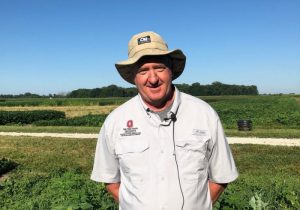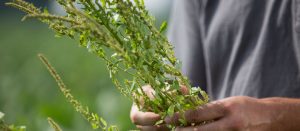Prevent plant acres and rogue weeds: Having a control plan is the key
By Dusty Sonnenberg, CCA, Ohio Field Leader
With prevent plant acres abundant in 2019, some fields experienced a huge increase in the weed seed bank. For some of those fields, pre- and post- herbicide applications were delayed, or did not occur at all. In other fields, weed control was attempted by mowing and tillage prior to seed development. Looking ahead to 2020, weed management could be a challenge.
“This is one of those time you do not want to cut out any of your pre- herbicides or cut rates on your post-,” said Mark Loux, Ohio State University Extension weed scientist.
The three primary weeds of most concern coming out of the 2019 prevent plant acres include: waterhemp, ragweeds, and marestail.
“Farmers need to be sure to have a comprehensive effective herbicide program that includes; effective burndown or tillage, a full rate of preemergence herbicide with residuals, and choosing an effective post emerge soybean trait system,” Loux said.

There are a couple strategies to tackle the prevent plant weed issues. Farmers can delay planting to allow more weeds to emerge, then they need to decide if they will use tillage or herbicide to control the weeds.
If tillage is planned, multiple tillage passes spaced a few weeks apart will stimulate additional emergence, and each new set of weeds can be taken out by tillage. If farmers are going to use a moldboard plow to flip the soil and weed seeds deep, they should not flip it again. The weed seed should be left buried deep. If shallow tillage is used, it will bury some weed seed for the current year, however the next shallow tillage pass will bring some of them back up to the surface.
No-till is another option to leave the weed seed on the surface and control it with herbicide applications. The downside to this is the longer a farmer waits to spray, it creates a more difficult burndown situation in no-till fields if the weeds get too big. Often times however, the seed will emerge sooner and degrade faster if left on the surface.
Every weed species is different, and the seed production and seed longevity is unique. A single giant ragweed plant can produce 5,000 seeds, and those seeds can be viable for up to 4 years. A marestail plant can produce 200,000 seeds and they can be viable for up to 4 years. A redroot pigweed can produce 229,000 seed and be viable for up to 40 years. Palmer amaranth and Waterhemp can produce up to 1 million seeds in a single year, and they can be viable for up to 4 years.
Giant ragweed has effectively been controlled because the seed production is low relative to other weeds, and the viability is not very long. Marestail can be a problem because of the large number of seeds produced and the longevity of the seed.

Palmer amaranth and waterhemp are a challenge because of the large number of seeds produced. Palmer amaranth and waterhemp have a relatively short viability, especially when buried, however the numbers still pose a control challenge. The deeper Palmer amaranth and waterhemp are buried, the better the control will be.
Loux shared some tips for preventing Palmer amaranth and waterhemp from getting out of control.
“Use residual herbicides as your first line of defense,” Loux said. “Know what the weeds look like, and scout fields from late July through September. If needed, request help for proper identification. Look for mature plants and mature seed, and remove the Palmer amaranth and waterhemp plants from the field to prevent the spread of the seed, rather than running them through the combine.”
Soybean trait technology is another excellent tool to aid in the control of rogue weeds. There are a variety of trait technologies available including: Roundup Ready and Roundup Ready2Yield; LibertyLink; Extend, which includes glyphosate and dicamba tolerance (XtendiMax, FeXapan, Engenia); LibetyLink-GT27 which are tolerant to glyphosate, Glufosinate, and isoxaflutole, (Roundup, Liberty, and Balance); and Enlist with glyphosate, Glufosinate, and 2,4-D choline tolerance.
When choosing a soybean trait, farmers should evaluate how much of a problem specific weeds are, such as marestail, giant ragweed, waterhemp, Palmer amaranth, and common ragweed. “LibertyLink, LibertyLink-GT27, Extend, and Enlist are all excellent programs for marestail, Giant ragweed, and common ragweed. They rate as good for waterhemp and Palmer amaranth,” Loux said. “The RoundupReady programs now have a lot of holes when it comes to glyphosate resistance in many of the rogue weeds. It is important for farmers to use different modes of action in a comprehensive herbicide program to slow the development of resistance to these other herbicides.”